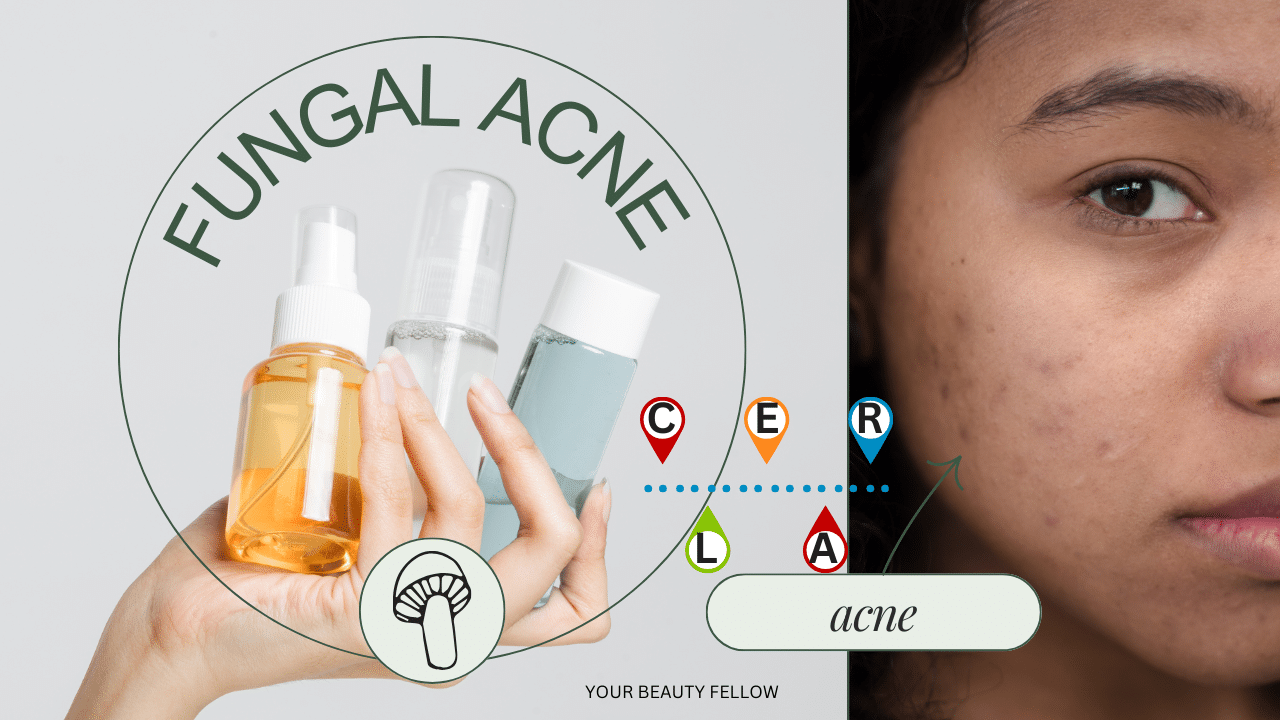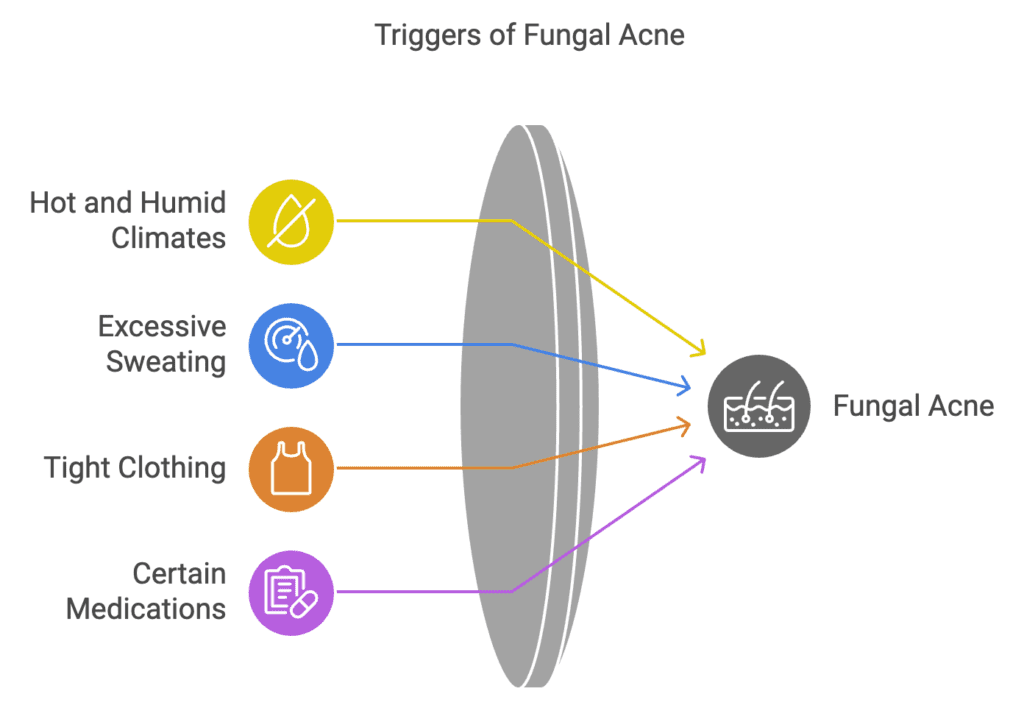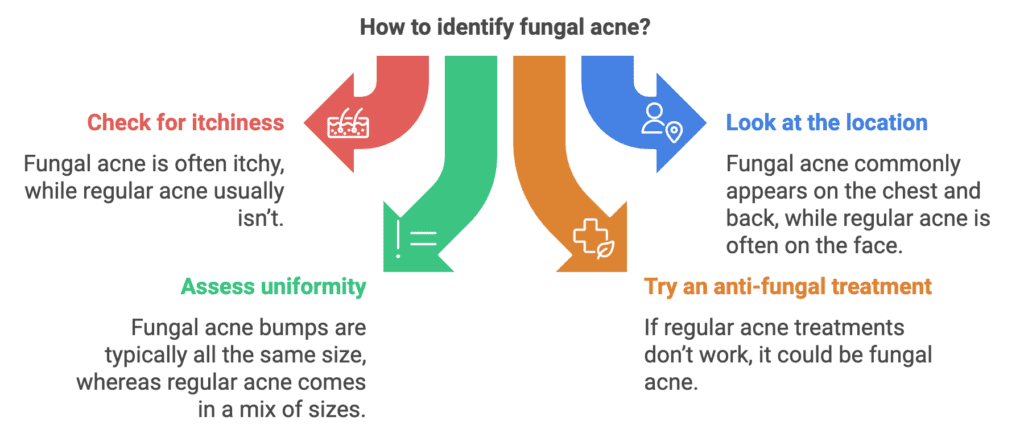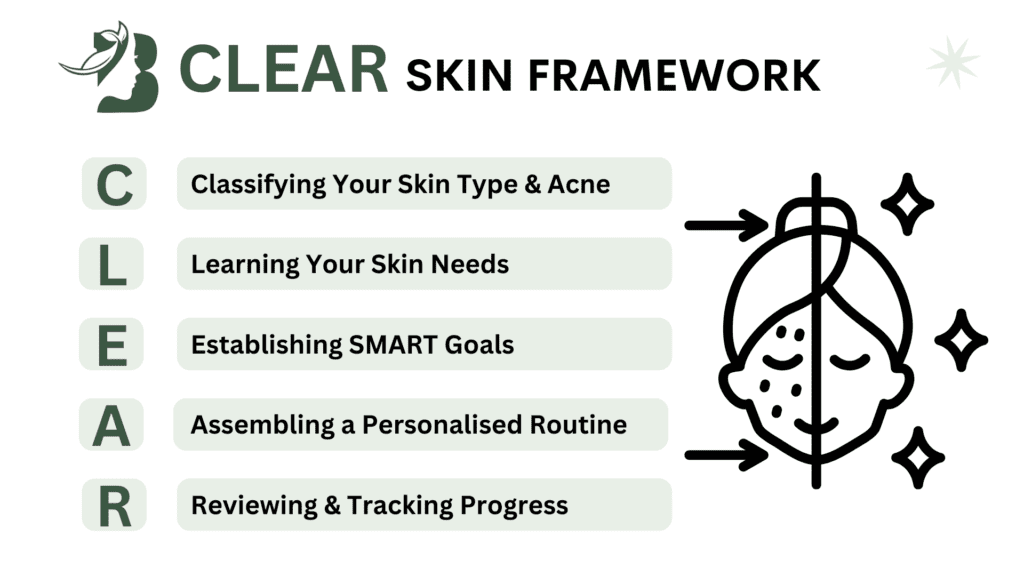
Have you been battling persistent acne that just won’t respond to your usual treatments? You might be dealing with fungal acne, a commonly misdiagnosed skin condition that requires a completely different approach than regular acne. As a skincare coach with over a decade of experience, I’ve seen countless clients struggle with this exact situation – using traditional acne treatments that only made their fungal acne worse.
In this comprehensive guide, we’ll explore the crucial differences between fungal and regular acne, helping you finally identify what you’re dealing with and create an effective treatment plan. Using the proven CLEAR Skin Framework, you’ll learn how to not only identify your specific condition but also develop a personalised approach for lasting results.
What Is Fungal Acne?
Despite its name, fungal acne isn’t acne at all. Scientifically known as Malassezia folliculitis, it’s caused by an overgrowth of yeast called Malassezia. This yeast is naturally present on your skin, but when its balance is disrupted, it can lead to inflammation, clogged hair follicles, and acne-like bumps.
What Causes Fungal Acne?
The overgrowth of Malassezia is often triggered by:
- Excessive sweating: Warm, humid conditions encourage yeast growth.
- Oily skin: Malassezia thrives on sebum (oil).
- Tight clothing: Traps heat and moisture, creating an ideal environment for yeast.
- Antibiotic use: Alters the skin’s microbiome, allowing yeast to dominate.
- Weakened immunity: Reduces your skin’s ability to keep yeast in check.

Fungal Acne vs. Regular Acne: Key Differences
Proper diagnosis is critical, as fungal acne requires anti-fungal treatments rather than traditional acne products. Here’s a quick guide to differentiate the two:

| Feature | Fungal Acne | Regular Acne |
|---|---|---|
| Cause | Overgrowth of yeast (Malassezia) | Clogged pores + C. acnes bacteria |
| Appearance & Sensation | Small, uniform (1-2mm), itchy red bumps or burning | Blackheads, whiteheads, cysts, pustules, rarely itchy |
| Common Locations | Chest, back or foreheads | Face, neck, back, shoulders |
| Response to Treatments | Unresponsive to regular acne products | Responds to acne-specific treatments |
Pro Tip: If you notice your breakouts get worse after using benzoyl peroxide or salicylic acid, you may be dealing with fungal acne.
The CLEAR skin Framework for Fungal Acne Treatment
The CLEAR Skin Framework provides a step-by-step, personalised approach to treating fungal acne. Here’s how to apply it:

1. Classify Your Condition
Before starting treatment, confirm the symptoms:
- Clusters of itchy, uniform bumps on oily areas.
- Persistent breakouts despite using acne-specific products.
- Worsened symptoms in humid conditions.
2. Learn Your Triggers
Document potential triggers such as:
- Environmental factors: High humidity, sweating.
- Skincare products: Heavy, oil-based moisturisers or makeup.
- Diet: High sugar and refined carbs can fuel Malassezia.
3. Establish Treatment Goals
Set realistic timelines:
- Immediate relief: 1-2 weeks (reduced itchiness).
- Noticeable improvement: 2-4 weeks (fewer bumps).
- Clear skin: 6-8 weeks with consistent treatment.
4. Assemble Your Routine
Morning Routine
1. Cleanser: Use a gentle antifungal cleanser like one with zinc pyrithione or selenium sulfide.
2. Treatment: Apply a fungal-safe moisturiser if needed.
3. Sunscreen: Opt for a zinc-based, non-comedogenic sunscreen.
Evening Routine
1. Double Cleanse: Use a fungal-safe oil cleanser followed by an antifungal wash.
2. Active Ingredient: Spot treat with ketoconazole cream (available OTC or via prescription).
3. Moisturiser: Light, oil-free, and fungal-safe.
Weekly Routine Enhancements
- Use tea tree oil (5% dilution) for spot treatment.
- Try raw honey masks for its antimicrobial properties.
5. Review and Adjust
Track your progress:
- Take weekly photos of affected areas.
- Keep a journal noting symptom intensity, diet, and environmental changes.
- If symptoms persist beyond 8 weeks, consult a dermatologist.
Top-Rated Products for Fungal Acne
- Zinc Pyrithione Soap – Ideal for daily cleansing.
- Ketoconazole Shampoo – Use as a body wash 2-3 times a week.
- Selenium Sulfide Lotion – Effective for stubborn areas.
Pro Tip: Always patch-test new products to avoid adverse reactions.
Oral Anti-fungals (For Persistent Cases)
In some cases, oral anti-fungals like fluconazole may be prescribed for faster results, particularly if topical treatments aren’t enough.
Prevention & Long-Term Management
Daily Strategies
- Stay Dry: Shower immediately after sweating and pat skin dry.
- Choose Breathable Fabrics: Wear loose, cotton-based clothing.
- Switch to Fungal-Safe Products: Avoid heavy, oil-based moisturisers.
Diet and Lifestyle Tips
- Reduce sugar and refined carbs, which can feed yeast.
- Incorporate probiotics to restore gut-skin balance.
Maintenance Routine
Even after clearing fungal acne, maintain your skin with:
- Regular use of anti-fungal cleansers.
- Lightweight moisturisers that won’t clog pores.
- Consistent sun protection with non-comedogenic sunscreen.
Conclusion
Proper diagnosis is crucial for effective treatment. Fungal acne thrives on oils, humidity, and disrupted microbiomes. Anti-fungal ingredients like zinc pyrithione and ketoconazole are game-changers. Consistency and prevention are key to long-term results.
Ready to take control of your skin health? Start by implementing the CLEAR Skin Framework steps outlined above, and remember that consistency is key. With proper identification and treatment, fungal acne is completely manageable.
Frequently Asked Questions
Q: How long does fungal acne take to clear? A: With proper treatment, improvement can start within 1-2 weeks, and significant results may be seen in 6-8 weeks.
Q: Can fungal acne come back? A: Yes, especially if triggers aren’t managed. Regular preventive care is essential.
Q: Is fungal acne contagious? A: No, fungal acne is not contagious. It’s caused by an imbalance of your skin’s natural microbiome.






